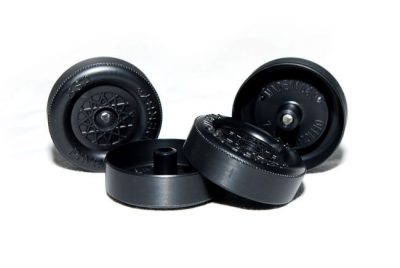Pinewood Derby Wheels
Pinewood derby wheels are made with an injection molding process. During this process, the plastic can blister due to heat of the mold or moisture content in the plastic chips. Those blisters cause imperfections in the pinewood derby wheels. Imperfections increase friction.
In 2009 BSA produced a new wheel mold. With the improvements to previous designs, today’s Pinewood Derby wheels require little preparation to be race ready when compared to previous molds. Unfortunately, most of your competitors will have the exact same wheels that are equally fast. After 12 years of production the molds are showing signs of wear. Thus, it is important to inspect your wheels prior to racing. No wheel mold is safe from flaws. Having good wheels helps a lot to get you to the finish line quicker.
How to Make PWD wheels Faster
Once you have sorted out your racing wheels, then it is time to prepare them for racing. Using proper PWD wheels tooling to prepare each part of the racing wheel will ensure that a wheel will be consistently matched to its other 3 wheels for the smooth quiet ride down the track. Proper tooling is the key. Stay away from the life-hacks you see some people showing. A shaved piece of metal with a wheel on a mandrel while spinning on a drill press is nowhere as safe or accurate as a wheel on a lathe or using the Pro Wheel Shaver.
Out of round pinewood derby wheels cause improper alignment at speed. This is something that is greatly mis-understood. An assembled derby car can roll perfect on a tuning board, but different things happen at max speed on the track. This is why we show all of our testing on a treadmill at 10MPH. As an out of round wheel travels down the track and gains speed the wheel will raise and drop which will cause the car to pull to one side or wobble back and forth depending on how bad or how many wheels are out of round. Once the death wobble starts, it never stops. If this happens to you, I recommend starting over.
Changing the profile of your pinewood derby wheels hub can give great advantages to reducing friction. Changing the profile eliminates the amount of friction between the axle and the wheel. Thus, allowing for a change in static and kinetic friction forces. Profile modifications include coned outer hubs and reduced outer hubs. Both accomplish the same goal and could be regulated by pack rules.
Do Not EVER skip pinewood wheel bore polishing
Finally, the last step would be to polish the pinewood derby wheels inner bore and hub surfaces to ensure a near frictionless surface. There is no substitute for removing manufacturing flaws from the injection molding process. Every millisecond adds up. Any plastic polish will work. You will first need a heavy grit to remove all the blisters, then you will need a final polish to make the surface smooth. Extreme racers will seal the bore with a wax or synthetic sealant then finish with a graphite burnish to pre-load the wheels prior to tuning (if using graphite). We offer polishing supplies if they are not readily available locally.

